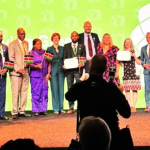At 7:30 am on Wednesday, a Kenya Wildlife Service helicopter took off into the clear skies above Nakuru National Park, carrying four census officials on a mission to count the country’s iconic species. The data crew comprised a pilot, a front seat observer, and two rear seat observers positioned on either side of the helicopter.
During the census, experts expressed confidence that the exercise would yield vital data to assist in decision-making. The team focused on determining the number and distribution of large mammals in the park. Their methods included aerial counts, ground counts, and spatially explicit capture-recapture techniques for carnivores.
Dr. David Ndeereh, head of research at the Wildlife Research and Training Institute, stated that the enumeration is part of Phase One of a national exercise that commenced on June 19. “We have been able to cover several landscapes, such as the greater Maasai Mara ecosystem, the Amboseli-Magadi ecosystem, Athi Kapiti, and Naivasha Nakuru ranches,” he explained.
The census aimed to count any animal larger than a Thomson gazelle. Ndeereh noted that while heavier fixed-wing aircraft were used in other regions, the helicopter was more suitable for the park, given its high wildlife density.
The census covers the greater Masai Mara ecosystem, Amboseli/Magadi, the Nairobi Athi-Kapiti landscape, and all closed sanctuaries, including Solio, Mwea, Lake Nakuru, and Ruma National Parks.
In Phase Two, the focus shifts to enclosed ecosystems—those that are fenced—where helicopters are employed. “So far, we have completed surveys of Mwea National Reserve, Solio, and Ruma National Park, and today (Wednesday), we are at Lake Nakuru National Park,” Ndeereh added.
The data being collected will inform management decisions and policy formulation as the country works towards enhancing wildlife conservation and management efforts.
“It will also assist us in assessing land use changes because the country is undergoing significant shifts in terms of land use. There is a lot of land demarcation and conversion of land for various purposes,” Dr. Ndeereh explained. Following the park census, officials will move to the marine ecosystem along the Kenyan coast, marking the conclusion of the first phase.
He emphasized that the wildlife sector has embraced new and emerging technologies. “Currently, we are utilizing remote sensing technology, which will help us monitor habitat changes over time since our first census in 2021,” he noted.
Upon landing, data captured on a dictaphone—used to record sound or speech—is downloaded and transcribed into a database. GPS data, consisting of tracks and waypoints (coordinates for identifying locations), is then merged with the transcribed voice data. The data is cleaned to identify and eliminate any potential double counts. Additionally, images are taken using cameras.
Ndeereh mentioned that Earth Ranger, an integrated technology, has been adopted to map and observe the movements of various wildlife species, particularly those fitted with monitoring devices. “We have animals, including elephants, giraffes, and lions, that are equipped with devices to help us monitor them in real-time,” he added.
So far, a substantial amount of data has been collected, which will require time to analyze. Ndeereh emphasized the need to connect all the dots before reaching any conclusions, stating that data must be verified. “The technical team will retreat to conduct further analysis on the data collected so far so that we can inform the country about changes in wildlife numbers and distribution. It is still very early to mention specific numbers,” he said.
After analyzing all the data, a comprehensive report will be produced. He also noted that a wildlife census should be conducted every three years, in line with ecological cycles of fertility and mortality.
Kenya is aiming to expand its wildlife conservation areas in line with the global biodiversity framework, which recommends that countries dedicate at least 30% of their landmass to conservation efforts.
Dr. David Ndeereh emphasized the importance of the wildlife census, stating, “We want to update our wildlife numbers in space and time. Since we conducted the first comprehensive wildlife census in 2021, the country experienced severe drought in 2022 and then flooding in early 2023. Those two events had an impact on wildlife.”
He noted that wildlife serves as a vital tourist product, making it crucial for the country to understand its species in order to effectively manage these resources. The current census follows one conducted from May to August 2021, which generated baseline numbers for wildlife and informed the review of the National Wildlife Strategy 2030 and the ongoing revision of the Wildlife Act.
The current count is being conducted at a cost of Sh302 million, with the Tourism Promotion Fund contributing Sh60 million to support the first phase. The 2021 census covered 343,380 square kilometers of Kenya’s landmass at a cost of Sh250 million. The results of that census revealed populations of 36,280 elephants, 897 black rhinos, 842 white rhinos, two northern rhinos, 2,589 lions, 5,189 hyenas, 1,160 cheetahs, 865 wild dogs, and 41,659 buffalos.
Phase two of the census is scheduled to commence in November. “Phase two will involve all the other areas where wildlife exists in Kenya,” Ndeereh confirmed.



